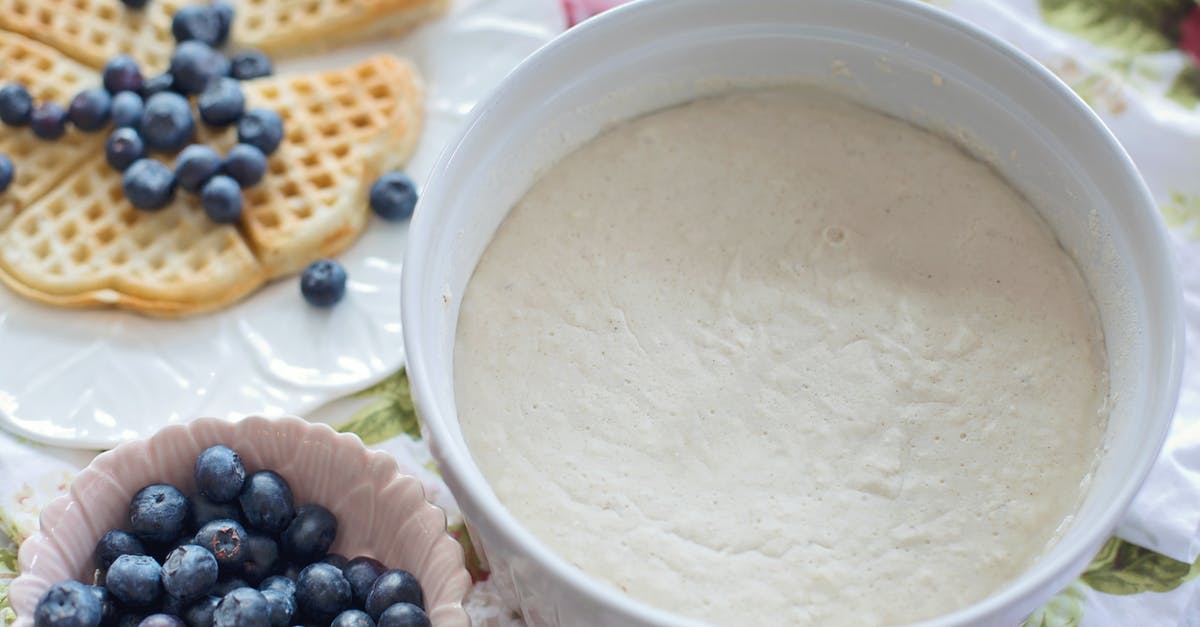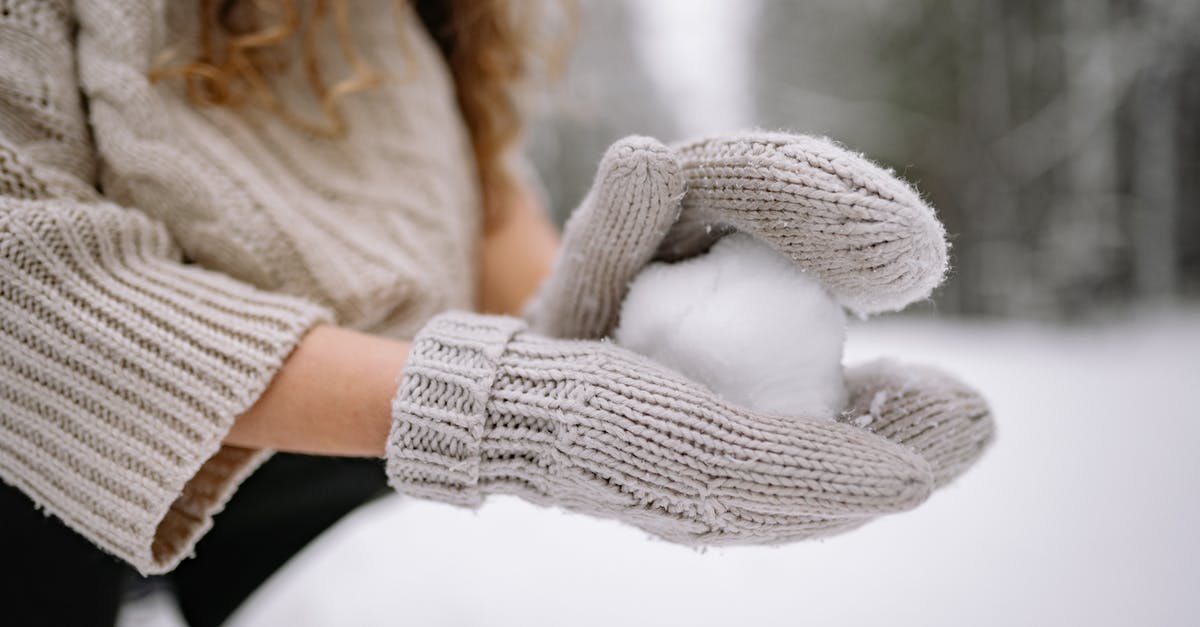Techniques for making sourdough starter in cold/altitude

I want to try my hand at making sourdough starter but live in high altitude and cold weather. I'm not sure if the altitude is an issue but I don't think my house is warm enough on its own to allow a starter to properly rise and ferment. Aside from I'm wondering if there are any other ways to create a warm, moist environment in which a starter could be successful.
Best Answer
You might want to try a desem starter. Have a look at the desem primer, which is also linked on the Wikipedia page. Starter instructions are given toward the end. Common lore says that desem starter should never get above 65F, which sounds perfect for your situation. (It's actually fine if it gets warmer than that, though.) Traditional conditions for creating a starter are 50-65F, and I imagine you must have an area at least in that temperature range. I don't think the high altitude should be an issue in getting a starter going, and it might actually help in the case of desem starter by allowing the internal sponge to grow slightly easier.
Basically, it's a dry dough sourdough starter -- different from the typical goupy or soupy sourdough starter most people work with. You begin a starter by essentially taking a little water and kneading in about as much whole grain flour as is reasonable to make a very dry little dough ball. (Whole wheat is traditional, but you can use other grains -- rye would probably be effective, but it's not traditional "desem.") Then bury it in flour. Standard practice is to throw half away every 24 hours and then add water and flour to repeat. You can also start with a very small amount and gradually enlarge the ball.
Eventually, you'll pull the ball out one day and it will be very soft and spongy inside. This will probably happen in about a week at low temperatures, but it could take more or less. At this point, I would usually do a few feedings 12 hours apart before using it to bake bread. If you want to ensure the strongest starter, I'd also do regular feedings for a few more days to really get the culture established.
You can easily convert a desem starter to a wetter version once it is established. Just add water to get the texture you want, and feed according to whatever starter recipe you want to follow.
And, of course, you can use to bake other kinds of bread. You can also convert it to another type of flour once established.
Why does this work better at lower temperatures? I've never actually tried it at very low temperatures (I've had success with a temp of 65F or so), but lots of people have. I think you might be able to get a more standard wet sourdough culture going with at least 50F temperatures -- I only recommend the desem method because anecdotally it's what a lot of people use at lower temperatures.
If it does work better, I assume it might have something to do with the way yeast and bacteria growth rates change at lower temperatures. Both are integral to a sourdough culture, but too much of one and not enough of the other, and the starter can fail. Early on in the creation of a starter, bacteria are much more active than yeast, and they produce a lot of byproducts, including acids which provide souring. In the first few days, you often end up with an excess of acetic acid (partly from bacteria that are undesirable and ultimately die off in the starter process), whereas a mature starter should produce more lactic acid. Excess acetic acid is known to be a significant inhibitor of yeast growth. So, at lower temperatures, the yeast may grow too slow and not have a chance to get established at all if there's too much acetic acid around. The high flour proportion in the desem starter could dilute the effect of all that acetic acid early on more effectively than in a wet starter. At least, that's what I'd theorize.
Regardless of the science, lots of people have success with the desem starter technique at lower temperatures. If you don't like maintaining that type of starter (which I personally have grown to like, because it seems to stay fresh longer with fewer feedings in the fridge once established), you can add more water once the starter is established.
As for allowing your dough to rise once you start baking, there are lots of ways to make a temporary humid warm space. If you have some small enclosed space that doesn't allow a lot of air circulation outside (microwave, small oven, etc.), put the dough in there along with a cup of hot water. Refresh the hot water as necessary to keep the desired temperature. If you don't have such a space, you can even take a large wider-than-tall cardboard box, cut off the top flaps, seal the bottom with packing tape, and invert it over your dough along with the cup of hot water. I used such makeshift proofing boxes for years until I actually was given a proofing box as a gift.
Frankly, you can let sourdough bread rise at lower temperatures, too, which will increase certain flavor elements. It will just take longer, and sometimes you might need to use a different amount of starter in the recipe so as not to end up with a loaf that's too sour in the end. But that will depend on the recipe and the specific characteristics of your mature starter.
Pictures about "Techniques for making sourdough starter in cold/altitude"



How do you make sourdough starter in cold weather?
If the normal temperature in your home is below 68\xb0F, find a smaller, warmer spot to develop your starter. For instance, try setting the starter on top of your water heater, refrigerator, or another appliance that might generate ambient heat. Your turned-off oven \u2014 with the light turned on \u2014 is also a good choice.What temp is too cold for sourdough starter?
Why Does Proofing Temperature Affect the Flavor of Sourdough?Temperature RangeFermentation TimeHot (e.g. Very Hot Sunny Day)82F \u2013 85F (28C \u2013 29C)Short (4 \u2013 6 hours)Warm (e.g. Room Temperature)70F \u2013 75F (21C \u2013 24C)Medium (6 \u2013 12 hours)Cold (e.g. Fridge Temperature)35F \u2013 50F (2C \u2013 10C)Long (12 \u2013 24+ hours)Does altitude affect sourdough starter?
Altitude does not have a profound affect on your sourdough starter. While there are many adjustments you'll need to make for a successful loaf of sourdough bread, your sourdough starter is more forgiving. If anything, you'll need to add slightly more water to compensate for the lower humidity levels and drier flour.Can you make sourdough with cold starter?
No! You can't use a sourdough starter straight from the fridge. In most cases, you will need to feed the starter and let it peak before you try to use it to bake bread. Of course, like most things, there are a few exceptions.How to Make a Sourdough Starter Recipe (Levain) // FOOL PROOF PROCEDURES
More answers regarding techniques for making sourdough starter in cold/altitude
Answer 2
Do you have a hot water heater? The room or the closet that houses it should be warm enough. That's where I grow my starter. (That's also where I bulk ferment and proof my loaves).
The altitude is not an issue. There are yeasts and bacteria on top of Mt. Everest.
Here's a schedule for you:
DAY 1 8:00 AM Sterilize container, add 190 g water @ 78 F (26 C), 94 g bread flour, stir, cover, store in warm place (I store it in my hot water heater closet).
.
DAY 2 DO NOTHING. DON'T SHAKE. DON'T STIR. DON'T UNCOVER. DON'T EVEN PEEK.
.
DAY 3 DO NOTHING
.
DAY 4 8:00 AM _ Add 47 g water @ 78 F (26 C), 25 g bread flour, stir, cover, store in warm place.
.
DAY 5 DO NOTHING
.
DAY 6 DO NOTHING
.
DAY 7 DO NOTHING
.
DAY 8 DO NOTHING
.
DAY 9 DO NOTHING
.
DAY 10 8:00 AM Pour off all but 100 g starter, add 47 g water @ 78 F (26 C), 31 g bread flour, stir, cover, store in a warm place.
DAY 10 2:00 PM Add 94 g water @ 78 F (26 C), 63 g bread flour, stir, cover, store in a warm place.
DAY 10 8:00 PM Add 190 g water @ 78 F (26 C), 125 g bread flour, stir, cover, store in a warm place.
.
DAY 11 8:00 AM Pour off all but 100 g starter, add 47 g water @ 78 F (26 C), 31 g bread flour, stir, cover, store in a warm place.
DAY 11 2:00 PM Add 94 g water @ 78 F (26 C), 63 g bread flour, stir, cover, store in a warm place.
DAY 11 8:00 PM Add 190 g water @ 78 F (26 C), 125 g bread flour, stir, cover, store in a warm place.
.
DAY 12 8:00 AM Pour off all but 100 g starter, add 47 g water @ 78 F (26 C), 31 g bread flour, stir, cover, store in a warm place.
DAY 12 2:00 PM Add 94 g water @ 78 F (26 C), 63 g bread flour, stir, cover, store in a warm place.
DAY 12 8:00 PM Add 190 g water @ 78 F (26 C), 125 g bread flour, stir, cover, store in a warm place.
.
DAY 13 8:00 AM Pour off all but 100 g starter, add 47 g water @ 78 F (26 C), 31 g bread flour, stir, cover, store in a warm place.
DAY 13 2:00 PM Add 94 g water @ 78 F (26 C), 63 g bread flour, stir, cover, store in a warm place.
DAY 13 8:00 PM Add 190 g water @ 78 F (26 C), 125 g bread flour, stir, cover, store in a warm place.
.
DAY 14 STARTER IS NOW STRONG ENOUGH TO BAKE
.
DAY 15+ CONTINUING STARTER MAINTAINENCE as equal parts starter, bread flour, water (1:1:1), but much smaller quantities of each 2x per day, such as 30 g starter, 30 g bread flour, 30 g water. If not baking for an extended period, put starter in the refrigerator to lie dormant until needed. To wake starter from dormancy, feed equal parts starter, bread flour, water (1:1:1) in whatever quantities needed 3x per day for 1-2 days, then adjust starter feeding/hydration to suit recipe.
Answer 3
Adding to some of the advice above:
There are only two critical times when you need a warm (as in above 65F) atmosphere for your starter: when you're first starting it, and during the 2nd rising of bread. At other times, sourdough is very tolerant of cold, it just slows down. I keep mine in the fridge so that I get 3 weeks between batches. It's 5 years old now and still going strong.
It seems that you could fairly easily use any number of techniques to keep the sourdough warm during startup and during 2nd rising for bread. One easy one is a damp or waterproof covering and a cliplight with a 100W incandesent light bulb (old-style, so it makes heat).
Answer 4
I know this question is rather old, but given the large amount of inaccurate or downright wrong information, I'll provide another answer anyway. I've been working with sourdough for years now and went through a lot of testing and analyzing the results to get where I am now. First off, some general facts about sourdough:
Sourdough consists of lactic acid bacteria and yeasts for the most part.
Depending on what kind of lactic acid bacteria you have in your dough, they can be pretty tolerant to heat. However, the yeasts are not, especially in regions with cooler climate. Starting at 40°C your yeasts in the sourdough will start to die. Generally, do not heat the sourdough above 35°C and do not use any ingredients any warmer than this. Also keep in mind that the sourdough can be 1-2°C warmer than the environment, due to microbial activity.
Lactic acid bacteria produces lactic acid (duh!) and a bit of acetic acid. How much of the latter depends, again, on your culture and the temperature (colder = more acetic acid, warmer = more lactic acid)
Yeasts like it warm. Around 25°C is a good temperature. Less than 15°C should be avoided if you want well developed yeasts.
If you have cool temperatures, you can alleviate the problem of having weak yeast and very sour dough a bit if you use more water than flour (about 1:1.5 flour/water instead if 1:1 like you normally would use).
Ok so here is how you make a starter from scratch:
Preparation:
Clean your bowl thoroughly!
Use natural flour, bleached or otherwise treated flour will increase the chance of failure a lot.
If you have chloride in your tap water, boil it before use (depending on where you live, this might be a good idea either way). Let it cool down below 40°C before you use it, tho.
The starter
You'll get the best results if you can keep temperatures somewhere around 25°C-30°C, but I've also succeeded in making a starter at about 15°C (I don't have experience with temperatures below this).
Note: Use 50% more water if you have temperatures around 15°C. I found this works best with type 1050 rye flour initially (refer to http://en.wikipedia.org/wiki/Flour#Flour_type_numbers for a rough conversion of my german type numbers), but you can start using pretty much any type of flour after that (I've tested rice, buckwheat, wheat, rye, spelt, barley, millet, oat and corn). Wholemeal can work fine, too. Just don't use the all-purpose flour (the completely white one), as this doesn't really contain all that much microbes anymore.
The process is rather simple: After you add 100g flour and water initially, you simply stir every 12 hours and add another 100g flour and water every 24 hours (every other time you stir the dough, you add flour and water). Do this for 4-5 days.
During these 5 days, the following can happen and is perfectly normal:
The dough can smell bad. The smell should go away after a day or two.
The dough may get light brown or white spots on top. This can happen after day 2-3 and is the yeast.
The dough may have bubbles at first and then go completely "silent" again. This is because several microbes are fighting to become dominant. Usually the lactic acid bacteria will win here (which is what we want) and "overwhelm" the other bacteria, making them stop producing gases. After the lactic acid bacteria settled, the wild yeasts will start to grow, forming a stable culture with the lactic acid bacteria.
If one of the following happens, the sourdough went bad and you have to start over (maybe try a different flour):
There are red, black, blue, green or "hairy" spots on the dough. This is mold. Don't try to rescue anything, it's spoiled and should be thrown away.
It smells very extremely like vinegar. It's okay to smell sour, but it normally won't smell so sour that it's repelling.
Now you should have a good bunch of sourdough, which you can use to bake.
A final note: I wouldn't let sourdough bread raise twice. You should only do it if you have strong yeast in your sourdough and even then it often doesn't work as well as you may hope, since apart from the yeast, the lactic acid bacteria is also "eating" the starch in the dough, quickly diminishing the food supply for the yeasts. I had my best results with only letting the dough raise once.
Answer 5
As long as your home is above 50F the bacteria and yeast in your starter will still be reasonably active- it will just take longer for them to work. When fermenting bread longer almost always means tastier.
That said- starting a starter from scratch already takes a long time so I understand your desire to speed it along a bit.
First of all- creating a moist environment is not going to be as important as the starter will be regularly recharged with flour and water- it won't get a chance to dry out.
As for temperature, my suggestions would be similar as for making yogurt-
- in a turned off (or very very low) oven
- covered and on a heating pad
Answer 6
I feel like these answers are overcomplicating the issue.
If your house is cool but livable (say 60F or higher) you will get starter activity but it will be diminished.
The two easy ways to mitigate this are to keep your starter at a higher temp (say 80-90F) or to ferment the dough longer (12-18+ hours).
There are many ways to keep the starter at a higher temp, you can find a warm spot behind an appliance or refrigerator or up in the rafters, keep it in a warm water bath that you replenish, buy a small heater intended for terrariums or aquariums, or a yogurt maker. You could even keep it on your person.
If you add even a relatively weak and cool starter to dough and let it ferment for 12-18+ hours you will get good rising activity and good bread even if it is at a cooler temperature. This is another way to mitigate the weak starter.
Answer 7
I live in Richmond Hill just north of Toronto, Canada. The temperature in my house is kept at 18C (65F), and this is my 3rd attempt at making a sourdough starter with just water and flour. Two previous attempts failed probably because I was using just All Purpose White Flour and there was just not enough wild yeast in there. This time I used a 50/50 mixture of Whole Wheat with AP and I believe the wild yeast in the less processed WW made the attempt successful.
If you don't want to read the rest of the detailed post just remember the most important point is that in a cold room you need to put the starter in a warm 25C/75F water bath and re-heat the bath every 8-12 hours for the yeast to establish itself.
Day 1: 50g WW + 50g AP + 100g cold water that has been boiled.
Day 2: I see just a few bubbles, with a bit of sour smell.
Added 50g WW + 50g AP + 100g cold water that has been boiled (Nothing discarded, just double the weight)
Day 3: A lot more bubbles on the top but not on the side, very little rise in volume, with a very strong vinegar smell.
At this point I though that the smell is not right so I googled and found My sourdough starter is bubbling but not rising, suggestions?. I realized that my room is so cold that it may take 11-18 days for the starter to form. I also read that different micro organisms in the starter thrives at different temperatures. Lower temperature encourages the growth of lactic acid bacteria (LAB) which produce acetic acid, which explains the strong acidic smell of my starter right now. What I want is more lactobacilli (which produce the milder, more pleasant yogurt like smell) and wild yeast. Lactobacilli thrives at higher (25C+) while yeast likes 21-25C.
So I split my starter into two jars. Added 100g AP + 100g cold water that has been boiled to each jar (nothing thrown away, and I stopped adding WW). I then filled a big stainless steel pot with hot tap water and added some cold tap water to bring the temperature to about 25C (I used a candy thermometer). I put the the jars in the water bath and left them in a cold oven. Before I went to sleep I re-heated the water bath to 25C again.
Day 4: Checked at noon and found that my starter is bubbling like crazy, success at last! The vinegar smell is now replaced with a milder, more pleasant sour smell. I added 200g AP + 200g cold boiled water to each jar, and re-heated the water bath to 25C.
Day 5: The starter is bubbling so vigorous that it has more than doubled in volume and oozed out of the jars. I am not ready to bake bread yet, so I stirred the jars down, took out a cup of the starter to make a very nice sourdough chocolate cake https://www.kingarthurflour.com/recipes/sourdough-chocolate-cake-recipe and put the two jars into the fridge for future experimentation.
Addendum:
Today I baked my firsts sourdough loaves. Turned out pretty well. Not much sourness, which is good. I tried using the https://www.karenskitchenstories.com/2016/08/sourdough-hokkaido-milk-bread-with.html recipe, using only about 60g of starter from the fridge mixed with 60g of water and 60g of flour to triple it. But after a few hours there was not much activity. Tried putting it into the oven but I may have turn the heat up too much and since there is not much flour/water mixture there I may have killed the yeast. So I abandoned the recipe, took out another 100g of starter from the fridge and added 100g of water + 100g of flour and left it overnight. The next morning I can see bubbles so the yeast is alive but not vigorous. So I took the pot to my room where it is sunny today and left is sit there for about 4 or 5 hours. It became very bubbly (I have 600g starter, so othat is 300g flour + 300g water) and I mixed in with 5 cups of flour along with my tangzhong made with 1/3 cup flour + 2/3 cup water. I also added 1/4 cup Crisco oil with 6 TBSP of sugar. I kneaded it and added just enough water to make a smooth dough. I let it ferment for about 10 hours for the volume to double. Then I gently shaped the dough into 3 loaves, and left them in the cold oven overnight. The loaves have double in volume in the morning and I baked them straight away. The crust was not bad and the texture is quite nice. So sourdough starter can definitely rise the dough twice.
So the lesson here is that you need to make sure the starter is tripled under warm conditions (21-25C). The best way to do that is by using a water bath (hot water from faucet mixed with some cold water) and then leave it in the oven (without turning on the oven, of course). Maybe a good idea for you to get a cheap candy thermometer to make sure the water is not too hot. You also need to give the starter enough time to ferment. The final dough also needs at least 12 hours to rise properly.
Sources: Stack Exchange - This article follows the attribution requirements of Stack Exchange and is licensed under CC BY-SA 3.0.
Images: Jill Wellington, Yan Krukov, Arina Krasnikova, Tima Miroshnichenko
